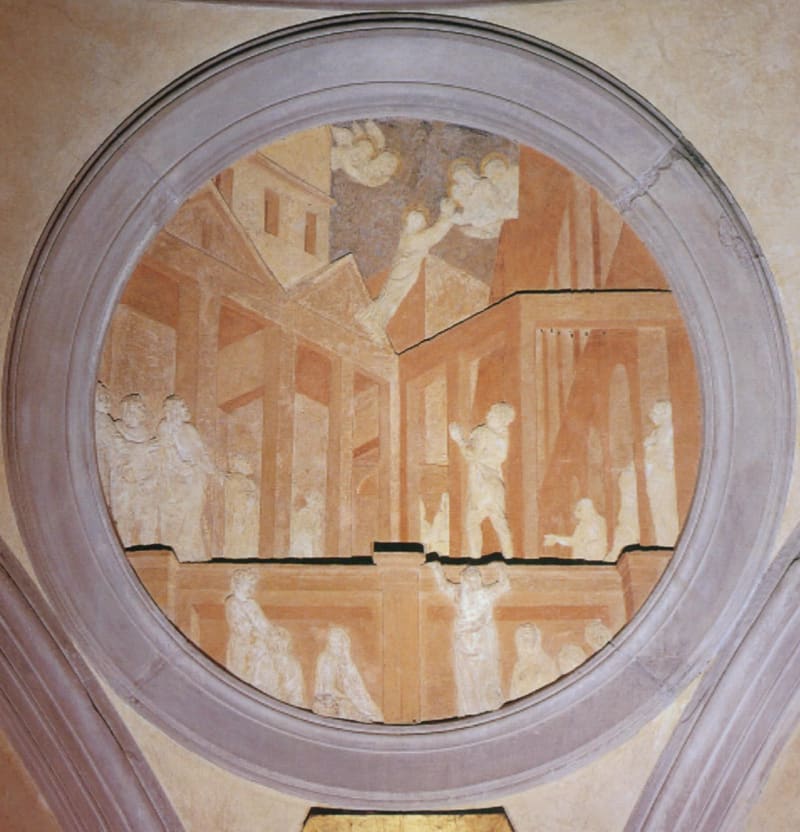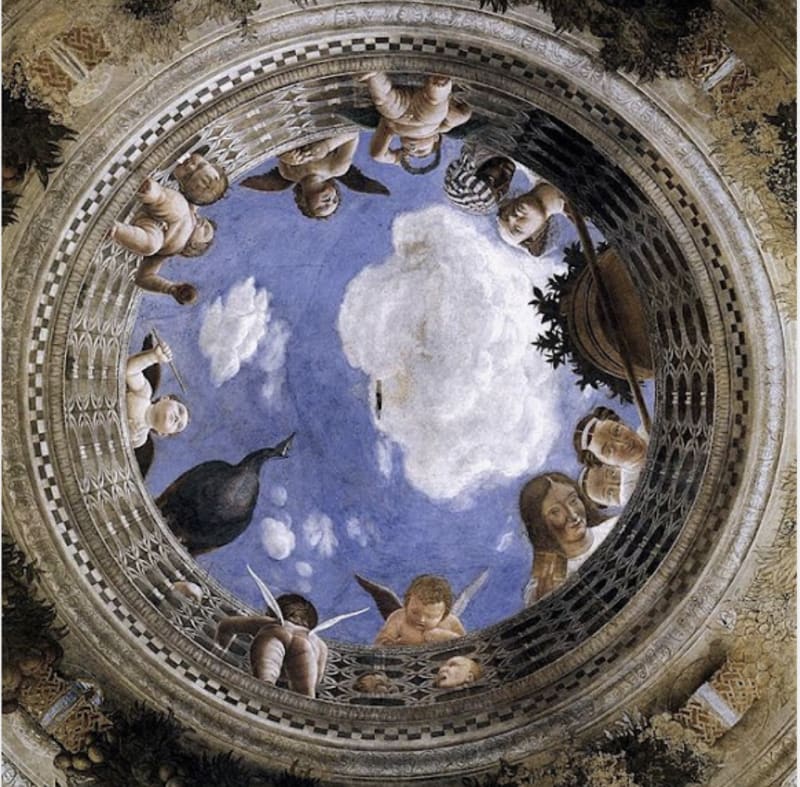Looking up

Arthur Parsey was a painter of miniatures who published an instruction manual in 1836 called Perspective Rectified, and in 1840 produced a much-extended edition, grandly retitled The Science of Vision.[1] Parsey was an argumentative polemicist with some eccentric and deluded obsessions. He claimed to have found a method of squaring the circle. In the second edition of his book, he proposed that ‘the seat of vision’ within the eye was the iris, not the retina. There were scathing reviews in the press. John Ruskin waded into the resulting correspondence under the pseudonym *Kata Phusin *(‘according to nature’) and gave Parsey some limited support.[2]
On one central point in perspective theory however, Parsey was absolutely right. If a perspective is drawn with the central axis directed upwards, the images of vertical lines in the scene will converge in the picture. Tall tree trunks or telephone poles will lean towards each other. Parsey claims to be the first theorist ever to have appreciated this. The frontispiece to The Science of Vision (see above) is a drawing by Parsey of a church, ‘Exhibited at the Royal Academy, 1827.’ The caption reads “This Plate is a Copy of the first Picture ever drawn with Optical accuracy.” The walls of the building do indeed converge slightly in the drawing and, if produced, would meet in a vanishing point way above the picture.
Parsey was wrong to claim that his was the first picture to show the convergence of verticals, although these have certainly been rare in art before the twentieth century. The earliest that I have found is an extraordinarily precocious bas-relief by Donatello: a tondo or circular decoration in the vault of the Old Sacristy of San Lorenzo in Florence, made some time between the late 1420s and the early 1440s. The subject is ‘The Ascension of Saint John the Evangelist’.

This is a three-point perspective: there is recession of the images of the buildings towards three vanishing points at the left, the right, and above the picture. The relief was made at the time when Alberti was working to formulate for the first time a procedure for constructing the simplest kind of one-point, frontal perspective, with convergence to a single vanishing point. I suspect that Donatello worked out his geometry intuitively, not using formal mathematical methods. But his vision is far ahead of the conventional history of perspective theory and practice.

Convergence of verticals can be seen in a different context in the quadratura paintings of the Baroque. Here the viewer looks directly upwards at paintings on ceilings. An early example is the circular oculus in the roof of the Camera degli Sposi in the Ducal Palace in Mantua, painted by Mantegna in the 1460s and 70s. Maids, putti, and a peacock peer over the balcony. The verticals of the balustrade meet in a vanishing point at the centre of the circle.

There are formal demonstrations of the convergence of verticals in Dutch perspective manuals of the seventeenth century. In an essay touching on Parsey’s work [3], Martin Kemp reproduces a virtuoso construction by Hendrik Hondius of a ‘Spiral Staircase in Perspective with Upwards Recession’. Spiral staircases have defeated many able perspectivists; Hondius’s spiral with vertical convergence is really impressive. Setting aside Parsey, it seems to be only in the twentieth century that artists begin to produce conventional drawings or canvases featuring buildings that taper upwards: notably Georgia O’Keeffe’s skyscraper paintings of the 1920s.
The question arises, why have artists been so reluctant to represent these effects? Our eyes are normally directed straight forwards of course, and the axis of our vision is generally horizontal. It has sometimes been suggested that people do not actually see vertical convergence when looking up. G B Moore in a perspective manual of 1850 says that “… buildings are known to be perpendicular, and few persons can perceive any apparent convergence of the upright lines.” [4] Maybe this blindness has something to do with a concern for structural stability in buildings. Any slight leaning might spell danger. I certainly see the phenomenon myself, although naturally I am highly attuned to perspective effects. But I think most people, looking up from the bottom of a well, say, or looking up between two skyscrapers, would say that the walls appear to get closer together towards the top.

Maybe the explanation is not to do with vision but with representation. People have not liked to see the effect in ordinary pictures including photographs. (Looking up at painted ceilings could be a different matter.) G B Moore says that when daguerrotypes were introduced, and early photographers pointed their cameras upwards, they discovered the ‘inclination of vertical lines’. This was seen as a fault, and cameras were developed with ‘rising fronts’, precisely so that tall buildings could be photographed without tilting the plate, and verticals in the scene would remain vertical in the picture. Even Hugh Ferriss, the American architect/draftsman and contemporary of O’Keeffe, who spent his career making dramatic charcoal renderings of the new skyscrapers, still preferred to avoid vertical convergence.
- Arthur Parsey, Perspective Rectified, Longman, Rees, Orme, Brown, Green and Longman, London 1836: revised edition The Science of Vision, or Natural Perspective, Longman, London 1840
- See Iris Wien, ‘Constable and the dynamics of vision’, Tate Papers No 33, 2020, online
- Martin Kemp, ‘‘Perspective Rectified’: some alternative systems in the 19th century’, AA Files No 15, Summer 1987 pp.30-34
- G B Moore, Perspective: Its Principles and Practice, Taylor, Walton and Maberly, London 1850, 2 vols: Vol 1 p.20